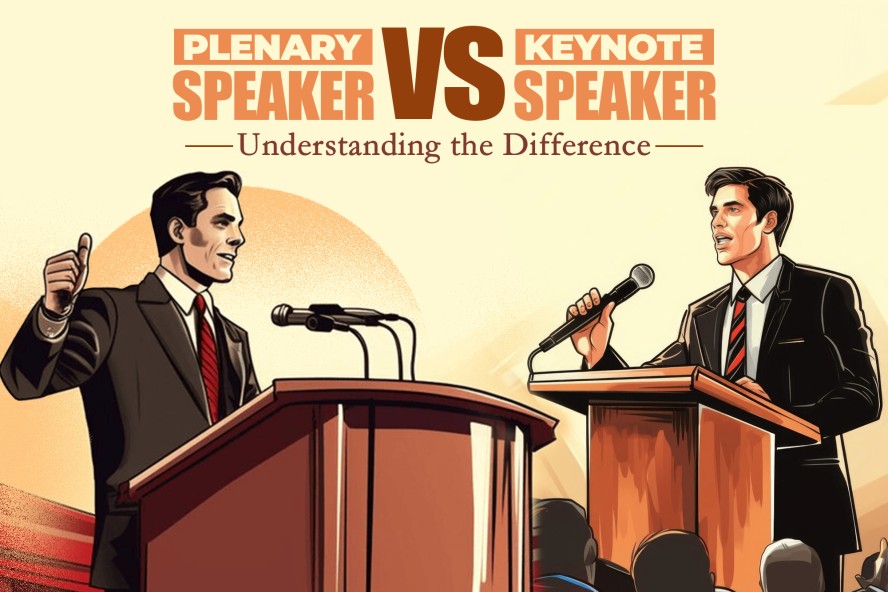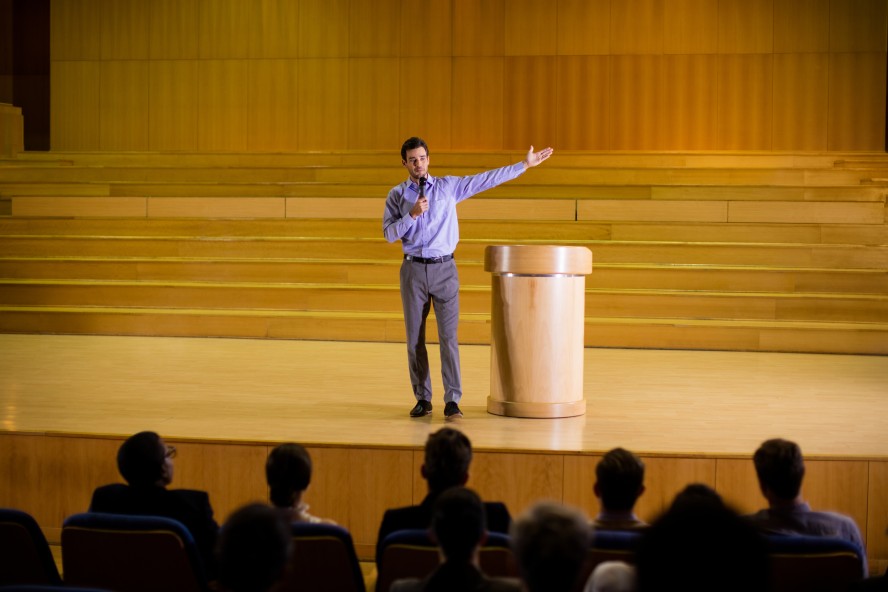
Ever been at a conference or event and wondered, ‘What’s the difference between a plenary speaker and a keynote speaker?’ You’re not alone!
These titles can be confusing, but they’re important. Here’s a simple breakdown: the plenary speaker is like the main act, while the keynote speaker kicks things off. Stick with us as we unravel what makes each one special and why knowing the difference matters when you’re at an event.
Who is a Plenary Speaker?
A plenary speaker is a presenter who addresses the entire audience of a conference or event during a plenary session, which typically involves all attendees gathered together in one central space. Plenary speakers deliver engaging, informative, and often inspirational talks catering to the audience’s diverse interests and backgrounds.
Here are some qualities of a good plenary speaker:
- Expertise: A good plenary speaker is an expert in their field, possessing in-depth knowledge and understanding of the subject matter they are addressing. Their expertise lends credibility to their talk and instills confidence in the audience.
- Engaging Communication Skills: Effective communication is key for a plenary speaker. They should be able to convey complex ideas clearly and understandably, keeping the audience engaged and interested throughout their presentation.
- Charisma and Presence: A good plenary speaker exudes charisma and has a commanding presence on stage. They captivate the audience with their confidence, passion, and enthusiasm for their topic, making them compelling to listen to.
- Ability to Inspire: A great plenary speaker has the ability to inspire and motivate their audience. Whether through storytelling, sharing personal experiences, or providing practical insights, they leave a lasting impact that encourages action and reflection.
Who is a Keynote Speaker?
A keynote speaker is a featured presenter at an event who sets the tone, theme, or main message of the gathering. They often speak at the beginning of the event, delivering a high-impact talk intended to capture the audience’s attention and generate enthusiasm for the rest of the program. Keynote speakers are typically chosen for their expertise, influence, and ability to inspire and engage audiences.

If you wish to learn more about keynote speakers and how to become one, you can also check out our Step-by-Step Guide to Becoming a Keynote Speaker. Meanwhile, here are some qualities of a good keynote speaker:
- Visionary Leadership: A good keynote speaker possesses visionary leadership qualities. They offer unique insights and perspectives that inspire others to think differently and embrace new ideas. They have a clear vision of the future and can articulate it in a compelling and persuasive manner. If you wish to learn more persuasive speech delivery methods, read our article Top 27 Public Speaking Podcasts to be an Ace Keynote Speaker before your next speaking gig.
- Inspiring Storytelling: Keynote speakers are adept storytellers who weave personal anecdotes, experiences, and examples into their presentations. They connect with the audience on an emotional level, leaving a lasting impression and inspiring action through the power of storytelling.
- Adaptability and Flexibility: A good keynote speaker is adaptable and flexible, able to tailor their message to suit the specific needs and interests of the audience. They can adjust their delivery style and content on the fly, ensuring maximum relevance and impact for each audience they address.
- Interactive Engagement: While keynote presentations are often one-way communication, a good keynote speaker finds ways to engage the audience and encourage participation. Whether through interactive polls, audience Q&A sessions, or group activities, they create opportunities for dialogue and connection.
Plenary Speaker vs Keynote Speaker – Key Differences
Here’s a comparison of the key differences between a plenary speaker and a keynote speaker:
Basis | Plenary Speaker | Keynote Speaker |
Role | Addresses the entire audience during a plenary session. | Sets the tone and theme at the beginning of the event. |
Audience Size | Typically speaks to all attendees. | Typically speaks to all attendees. |
Time Slot | Often part of a larger program | Often, the opening or closing speaker of the event |
Content Focus | It may cover a broad range of topics | Focuses on a specific theme or message |
Presentation Style | It can vary depending on the event format | Often, a high-impact, dynamic presentation |
Duration | It can range from short to long, depending on the event | Typically, a longer presentation |
Interaction | It may or may not involve audience interaction | May include interactive elements or Q&A sessions |
1. Role
The role of a plenary speaker is multifaceted, serving as a pivotal component in the overall success of an event. Plenary speakers address the entire audience during a plenary session, typically involving all attendees gathered together in one central space. Their primary objective is to inform, engage, and unify the audience by delivering a presentation that covers a broad range of topics relevant to the event theme or objectives.
On the other hand, the role of a keynote speaker is equally significant in shaping the trajectory of an event and leaving a lasting impression on attendees. Keynote speakers serve as the opening or closing speaker of the event, setting the tone and theme that will guide the rest of the program. Their presentations are carefully crafted to inspire, motivate, and energize the audience, capturing their attention from the start and creating a sense of excitement and anticipation for the event.
2. Audience Size
For both plenary speakers and keynote speakers, the audience size is the entire gathering of attendees at the event. Plenary speakers address the audience as a whole during a plenary session, which typically involves all attendees gathered together in one central space. This setting allows for a shared experience where everyone can hear the presentation simultaneously.
Similarly, keynote speakers also address the entire audience, as their presentations are usually scheduled at the beginning or end of the event when all attendees are gathered together. Keynote speakers play a critical role in setting the event’s tone and theme, capturing the audience’s attention and interest from the start.
3. Time-Slot
Plenary speakers may have their sessions dispersed throughout the event’s program. These sessions are often designed to accommodate various topics and may occur at various points during the event. They serve as key moments where all attendees gather to hear presentations covering diverse subjects relevant to the event’s overarching theme. The time slots for plenary sessions can vary depending on the event schedule and the content presented.
On the other hand, keynote speakers typically occupy prominent time slots at the beginning or closing of the event. Their presentations are strategically positioned to set the tone and theme for the entire gathering. The time slots allotted for keynote presentations are often longer compared to other sessions at the event, allowing for a comprehensive exploration of the speaker’s chosen topic and maximizing their impact on the audience.
4. Content Focus
Plenary speakers often cover a broad range of topics during their presentations. Their content may encompass various subjects relevant to the event’s theme, catering to the diverse interests and needs of the audience. Plenary sessions expose attendees to different perspectives, insights, and expertise from expert speakers across various fields.
In contrast, keynote speakers focus on a specific theme or message that sets the tone for the entire event. Their presentations are carefully crafted to deliver a clear and impactful message that resonates with the audience and aligns with the overall objectives of the gathering. Keynote speakers delve deeply into their chosen topic, providing in-depth insights.
5. Presentation Style
Plenary speakers adapt their presentation style based on the event format, audience demographics, and subject matter. They may utilize various techniques, such as storytelling, visuals, and interactive elements, to capture the audience’s attention and convey their message effectively. Plenary presentations often aim to inform and educate attendees on a wide range of topics so that speakers may employ a more straightforward and informative delivery style.

In contrast, keynote speakers typically deliver high-energy, dynamic presentations that captivate the audience from stepping onto the stage. They often incorporate storytelling, humor, and audience participation elements to create an engaging and memorable experience. Keynote presentations are carefully crafted to inspire, motivate, and set the tone for the event so that speakers may employ a more theatrical or inspirational delivery style.
6. Duration
Since plenary sessions typically cover a broad range of topics and may include multiple speakers or presentations, the duration of each individual presentation within a plenary session can vary. Plenary speakers may have anywhere from a few minutes to an hour or more to deliver their presentation.
On the other hand, keynote presentations are typically longer in duration compared to other sessions at the event. Keynote speakers often have a prominent time slot at the beginning or closing of the event, allowing them to delve deeply into their chosen topic and engage the audience more fully. The duration of keynote presentations may range from 30 minutes to an hour or more.
7. Interaction
Plenary speakers may or may not include audience interaction, depending on the event format and objectives. Some plenary sessions are designed as more traditional presentations where the speaker delivers their content to the audience without direct interaction. However, other plenary sessions may incorporate interactive elements such as Q&A sessions, polls, or group discussions. These interactive components allow attendees to actively participate in the presentation, ask questions, share insights, and engage in meaningful dialogue with the speaker and fellow audience members.
Similarly, keynote presentations may also include interactive elements or opportunities for audience participation. Keynote speakers may encourage audience members to participate in activities, respond to prompts, or share their thoughts and experiences throughout the presentation. Interactive engagement can enhance the audience’s connection to the speaker and the content, fostering a sense of involvement and ownership in the event experience. As a speaker, before your next speaking gig, check out these 15 Tips That Guarantee A Productive Q&A Session if you want to find out ways to make your session interactive and interesting.
Role of a Plenary Speaker
The role of a plenary speaker is pivotal in the success of any conference or event. During a plenary session, which typically involves all attendees gathered together in one central space, plenary speakers deliver a keynote presentation to the entire audience.
The role of a plenary speaker can vary depending on the specific goals and objectives of the event, but generally, their responsibilities include:
- Setting the Tone: Plenary speakers play a crucial role in setting the tone and atmosphere for the entire event. Through their presentations, they can establish the theme, agenda, and overall mood of the conference, helping to create a sense of excitement, anticipation, or gravitas, depending on the nature of the event.
- Providing Key Insights: Plenary speakers are often chosen for their expertise, knowledge, and unique perspectives on a particular subject matter. They are expected to deliver insightful and thought-provoking presentations that offer valuable insights, trends, and best practices relevant to the audience’s interests and needs.
- Inspiring Action: Plenary speakers have the power to inspire action and drive change among their audience members. By sharing compelling narratives, practical advice, and motivational messages, they aim to motivate attendees to apply what they’ve learned, pursue new opportunities, or enact positive changes in their personal or professional lives.

- Representing the Event: Plenary speakers act as ambassadors for the event, representing its mission, values, and objectives to the wider audience. They are responsible for delivering a memorable and impactful presentation that reflects positively on the event as a whole, leaving attendees inspired, informed, and eager to participate further.
Role of a Keynote Speaker
The role of a keynote speaker is crucial in setting the stage for the success of an event. Keynote speakers are typically chosen for their expertise, influence, and ability to inspire and engage audiences.
Here are some key aspects of their role:
- Setting the Tone: Keynote speakers kick off an event by setting the tone and establishing the overarching theme or message. They are responsible for capturing the audience’s attention from the start and creating a sense of anticipation and excitement for the rest of the program.
- Offering Practical Advice: Keynote speakers often share practical advice, strategies, and best practices that attendees can apply in their personal or professional lives. Whether it’s leadership principles, productivity hacks, or career development tips, they provide actionable takeaways that add value to the audience’s experience.
- Engaging the Audience: Keynote speakers employ various techniques to engage and connect with the audience, including interactive elements, audience participation, and dynamic delivery styles. They strive to keep attendees interested, attentive, and engaged throughout their presentations.
- Fostering Networking and Collaboration: Keynote presentations serve as a platform for attendees to connect, network, and collaborate with one another. Keynote speakers facilitate this process by fostering a sense of community and creating opportunities for interaction and dialogue among attendees.
Key Takeaway
While plenary and keynote speakers play essential roles in events, they have distinct differences in their responsibilities, presentation styles, and objectives.
Plenary speakers address the entire audience during plenary sessions, covering a broad range of topics and aiming to inform and engage attendees. Keynote speakers, on the other hand, set the tone and theme for the event with high-energy presentations focused on inspiring and motivating the audience.
Understanding these differences helps event organizers and attendees appreciate the unique contributions each type of speaker brings to the table. If you’re a new speaker looking for some inspiration, you should check out these 17 Exceptional Speaker Websites. You should also sign up for Eventible’s speaker directory, The Gazebo – B2B Speaker Directory. It’s a community of the most popular speakers as chosen by event attendees worldwide.
Also, to stay updated on all the latest information about the event industry, visit our site- Eventible.




Comments are closed.